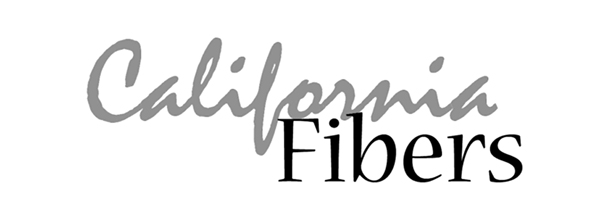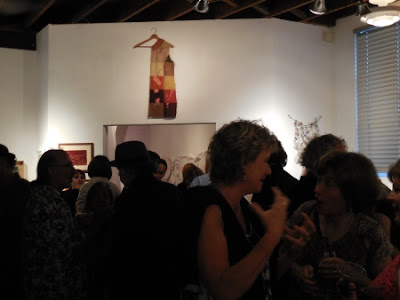California Fibers' members often reflect on how and why they work. A recent meeting brought up this question: How did you come to choose
fiber and your particular material[s] as your art medium?
Mary Beth Schwartzenberger, detail of River Writing
"I
started my artistic life as a photography major at Columbia College in
Chicago. I discovered that although I loved the art of photography,
it was too concentrated on the individual and lacked a sense of artistic
community. Then one day I walked into a room with floor looms and became
captivated. Weaving brought me into the world of fiber and I have never
left. For me as an artist, it had everything that made sense to me: work of the hand, a communal excitement for the craft, and a playground for
color and texture. Throughout the years, my medium has changed, but I maintain
my connection to fiber as a tool to bring texture to my work.
I
describe my painting technique as intuitive painting. I do not sketch first,
but I trust the paint to guide my hand. I enjoy the excitement of seeing a
piece develop, letting the colors determine my next step. For me, it
is important not to over think a piece, but to allow for that immediacy to
speak for the subconscious connections.
Yosemite
is a memory bank of images for me--reflections in the water, the colors in the
granite, the towering pines, and the meadow grasses. All of these
enter into my work to some degree.
As
the years have gone by, my work has gotten more abstract. It is now
more about tapping into the viewer’s imagination than my providing the
image. That is the power of abstract expressionism for
me. It allows the viewers to recall places, emotions, and
experiences. I like when each person sees something
different. For me, that defines a successful piece, because my
thoughts are out of the way. The door has been opened for the viewer to
experience the work and transform it into their personal journey."
--Mary Beth Schwartzenberger
VALYA, Engrams
"After I graduated from high
school at age 16, I applied to the Lviv Academy of Art in the fashion
department. Unfortunately, I didn't pass the exams, so I spent a year polishing
my drawing and painting skills in order to be ready for the next try.
Time came for a new
application. I went to the Academy with the necessary documents. In the
corridor I met my friend. We both were dreaming of becoming fashion
designers. She had just finished her application process. We chatted a little
and she casually said, 'You know, I decided to apply to the textile
department. They told me that fashion is not an art.' It was as if a
tornado crashed into my head. A few minutes later I applied to the textile
department, as well.
Five years later, I
successfully graduated from the Academy, and since then I have worked with textiles. I am thankful to God for sending me that shocking message
in that very important moment of my life, and I am happy that I was able
to follow my intuition. I have loved fiber ever since then.
P.S. In Ukraine, one must
apply to study in a specific department, and it is almost impossible to
transfer later."
--Valya Roenko
Cameron Taylor-Brown, Angels and Men Quartet
"I learned to sew in high school and quickly realized it
was the fabric I was attracted to. Later at UC Berkeley, I stumbled into a
lecture class taught by Ed Rossbach and never looked back. I had no idea he was
a seminal figure in the fiber art movement. I just knew he inspired
me. He invited me to learn to weave with his grad students because there
wasn’t an undergraduate textile program at Berkeley. My first weaving
experience was on a draw loom, which may be why I still have a fascination with
textile structures."
--Cameron Taylor-Brown
Kathy Nida, Tsunami
"I didn’t start out in fiber with my art…I drew and
screenprinted. I did learn to sew when I was a kid, though. Sewed many of my
own clothes through college…so the fiber was there. Mom was a weaver too.
Before the kids were born, I took a few quilt classes locally, not art
quilts…just a variety of piecing techniques. Then I joined up with a quilt
guild and discovered art quilts, so I tried a few out. What finally pushed me
into quiltmaking as art, though, was the birth of my children. I love the
graphic style of screenprinting, but the time to make a screen, print it, and
then clean it is just not available when you have small kids. I can carry a lot
of my quilt supplies around with me…I’ve sewed or cut stuff out at music class,
soccer games, scout events, and waiting in doctor’s offices. It’s much more
portable and I can do a little here and there, without having to commit to
printing this many and then cleaning up, which is a huge time investment. Also
the color palette in fabric is so much more interesting with the addition of
patterns and hand-dyed fabrics, so I never went back to screenprinting."
--Kathy Nida
Lynne Hodgman, Oceanic Grammar
"I am returning to my
art roots by choosing textiles, and particularly paper, writing, and stitching,
as my current mediums/processes. I learned to stitch very young, at about
the same time I learned to write. I made--and still make--lines/marks with hand sewing, machine stitching, and pen/pencil on paper. Much of my
work now includes written text in some form, and I think of writing, drawing,
stitching, and crocheting/knitting as activities along a continuum of
mark-making. I enjoy the promise of a blank piece of paper, especially
handmade paper, as much as the pleasures of printed and woven fabrics."
--Lynne Hodgman











































